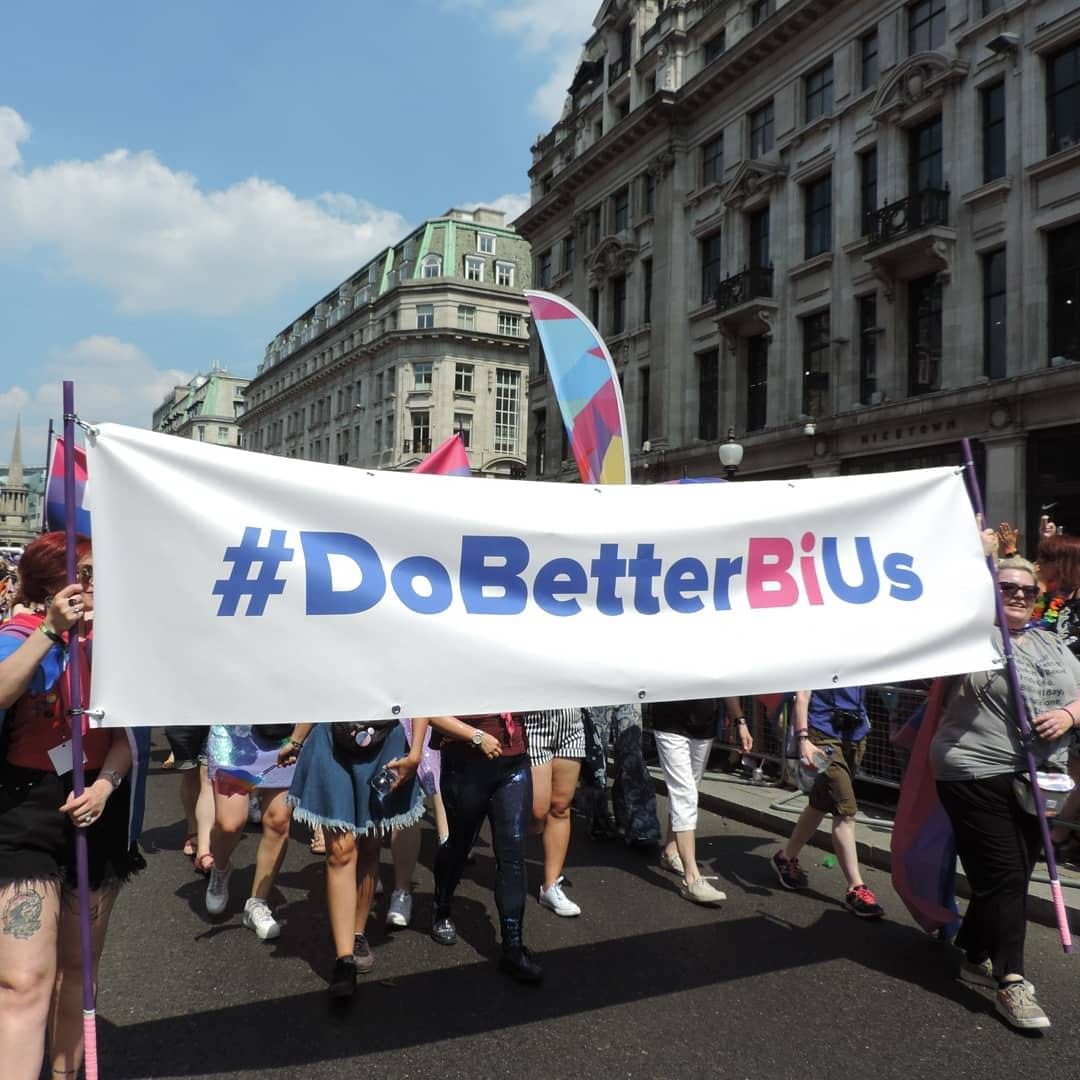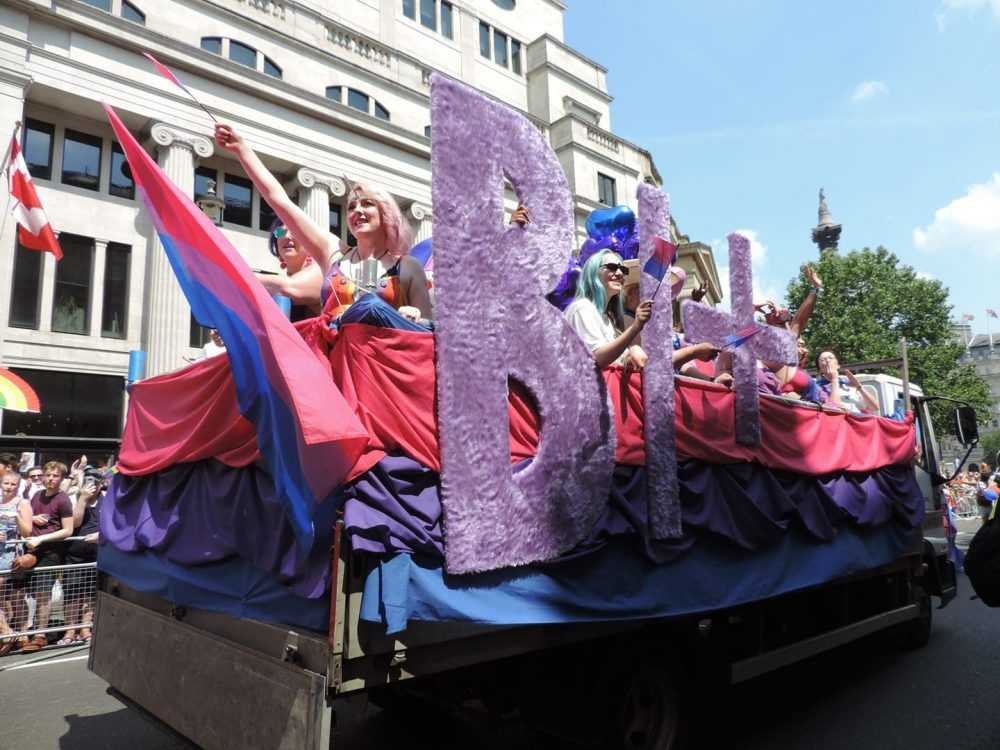The importance of bi blocs at Pride.
On Saturday 7 July, I re-dyed my hair an especially vibrant purple, sat on a heaving train full of glittered faces and rainbow flags and then took my place on the first bi float ever to appear in London’s Pride march. Hand on heart, it was the best Pride experience I have ever had.
As I mounted the extravagantly decorated vehicle, a sea of hands reached out to help me on. The mood was one of genuine solidarity and excitement.
There was a sense that many of those present were experiencing what it really felt like to be yourself in an LGBT space for the first time.
The float was the brainchild of Libby Baxter-Williams, Director of Biscuit, a fast-growing UK-based bisexual women’s campaign group. She was inspired to organize the float after coming to blows with organizers last year over the fact that a bi float had never featured in the parade.
“I caused a massive furor for Pride last year because they treated us so badly,” she told Curve. “They were convinced that bi people weren’t really interested in Pride. As that was going down, I was saying to everyone who would listen ‘I think I’m going to try and organize a float next year. I had no idea how I was going to achieve it but then I realized I’d said it to quite a large number of people so I was going to have go through with it!” Libby put out some initial feelers but found that not as many other bi groups as expected were keen to get involved.
“I didn’t do anything about it for a couple of months until I thought ‘Well, I have nothing to do for the next hour and a half, so I’ll write the crowdfunder,’ she recalls. “I published the crowd funder on a Friday night, on the train on my way to see my girlfriend, and then spent the whole weekend saying ‘Can you not touch me! I am watching the money pouring in.’ Within 36 hours it had reached its target and within 48 hours we’d reached our stretch goal. We raised about £2,500 in a weekend, just from within the community.”
However, Libby’s delight was short-lived when she realized just how much more money she’d actually need…
“I really thought that would be enough to cover everything,” she sighs. “If we’d just done the float, it would have been. But the whole point was to have a huge presence. We normally have a 50-person walking group, but this time we had a large float – the biggest float size they would let us have – plus 150 people walking with us, plus another 150 people walking with Bi Pride, plus the stall in the Pride London Community Village. The stall was stocked with materials like postcards and badges, mostly made by Biscuit.”
Libby has learned from her mistakes and is working alongside colleagues with on a guide for other bi campaigners wishing to follow in her footsteps. “The guide will explain everything people need to consider before the day,” she explains. “It’s a process that really needs demystifying. It will include all the things which were unexpected for us, such as how much insurance really costs and how much of the stuff that we hired wasn’t available without insurance.” Libby stresses the fact that many bi groups find funding an issue because of their size and reach. “The whole thing was stressful but I think that’s mainly because Pride is not set up to help small community groups.
Pride really wants small community groups to be involved, but they mainly have their attention focused on corporates. That’s not on purpose necessarily – obviously, some of it is because they need the money – but it can be daunting as a newbie without significant cash behind you to set up a float and/or marching group.”
Libby felt that the float “legitimized” the bisexual presence on the march, meaning fewer incidences of biphobia were reported. “The bigots were disempowered,” she says. “But there is always some level of biphobia at Pride. I heard the MC/crowd announcer say: ‘Here come the greedy ones – they’re here, so they must have made their minds up’ when we went past.”
Responding to suggestions that having a specific bi float further isolates bisexuals from the LGBT community, Libby says: “We didn’t annex ourselves, we were pushed out of the LGBT umbrella, so I don’t think that having a separate bi bloc is a bad thing or that it alienates us further.”
The front of this year’s Pride London march was unfortunately sabotaged by a group of protestors carrying anti-trans signs bearing slogans such as “TRANSACTIVISM ERASES LESBIANS”. “The same group of people who demonized bisexuals in the 90s are now demonizing trans people, and in particular trans women,” Libby says. “At Toronto Pride in the mid-90s, lesbian separatists protested Pride in much the same way they protested this weekend against trans people, because they didn’t want bi people there. There is a huge overlap between the trans and bi communities and how we are connected. There is a shared willingness to understand gender as something more than binary.”

Our presence as bisexuals and bisexual allies at Pride marches is one of the most important tools we have in increasing bi visibility, not just within the LGBT community but in the wider public eye as well. The level of organization involved is not to be sniffed at, and cash really is a huge factor, but if we do our best to support one another then perhaps in the not-too-distant future, a bi float won’t be such a rarity at our annual local celebrations of LGBT Pride all over the world. Brenda Howard, the out bisexual woman also known as “the Mother of Pride” who was credited with organizing the first ever Pride march, would be proud of us.
www.twitter.com/we_are_biscuit
